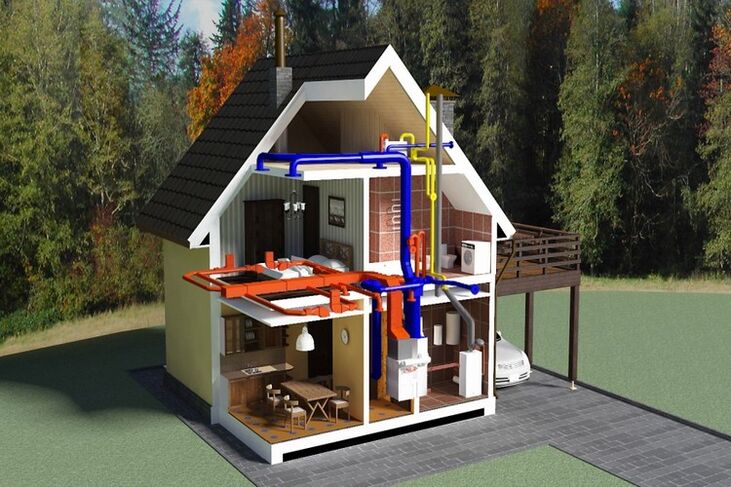Resource and energy saving technologies require a mandatory integrated approach to the production, distribution and consumption of electricity. And at the stage of building a house, modern energy-saving technologies are always combined with innovations in the construction field, since a significant part of the electricity is used to heat the house in cold weather and to cool it in hot weather. This immediately requires the planned use of energy-efficient materials. Furthermore, a customized home supply system will allow, in some cases, to completely abandon the traditional method of supplying electricity.
Technologies for energy saving in construction
The best example of energy saving technologies in construction so far may be the so-called "energy efficient houses", in which, ideally, in the winter, a comfortable temperature is maintained without using a traditional heating system, and in the summer without a system. of air conditioning.
Such structures, depending on the technological variations, are also called Zero Energy Houses - "zero energy houses" or "passive houses".
To get as close as possible to the standards of such a house, it contains:
- install a single boiler room or other source of heat supply, often by connecting pumps that return the heat of the exhaust air from the ventilation duct, the heat of the earth or sewage,
- replace part of the solar electricity (collector), and the direct energy of the sun, in turn, is competently used in accordance with the thermal balance of the building, connecting translucent and reflective structures,
- they use modern thermal insulation materials, and this applies to both building materials and communication systems.
The energy saving method described above assumes that the building becomes the final recipient of the electricity from the power plants. Now, however, the possibility of a complete transition to individual energy supply systems is being considered as an innovative practice, when the building itself, in fact, becomes a "power plant" and begins to distribute electricity to other consumers.

This is possible, for example, with the widespread use of nano-photovoltaic cells, which are defined as one of the most promising solutions. In Freiburg, Germany, the local institute for solar energy is using the space of the city as a kind of "testing ground" for testing solar technology, introducing solar panels into the stadium, rebuilding entire neighborhoods (58 residential buildings and an office building on the border between the neighborhood) for the new concept of "active houses" The main obstacle to the widespread adoption of these technologies is the high cost of ultra-pure industrial silicone, used for batteries (about 450 $ / kg ). It was replaced by nanotechnology and a special carbon - fullerene. But so far its efficiency is 2. 5 times lower than that of silicone solar cells.
Energy saving technologies in everyday life
The main direction in the creation of energy saving technologies in everyday life is the individual regulation of energy consumption using "smart" technologies, depending on:
- personal habits of residents and preferences in the microclimate,
- the period of the year (day) in which the "intelligent" system reconstructs itself by choosing to switch on and with what intensity to work.
For example, an automatic home lighting system turns on the light only when needed, turning it off during the day and turning it on in the evening when activated by sound through the built-in microphone. When noise occurs within a radius of 5 meters, an energy saving lamp lights up automatically, which does not go out while someone is in the room.
But until these "intellectual" innovations become dominant, experts recommend using "preventative saving" methods of electricity in everyday life, which include:
- replacement of incandescent lamps with energy-saving ones (with consumption reduced by 5-6 times) or even cheaper with LEDs,
- the transition to high energy efficiency class appliances (A- A +++), which, when compared with obsolete models, can show a difference of 50%,
- turn off devices (equipment) in standby mode: televisions, music centers and recorders, which still consume 3-10 W in a turned off but not turned off state,
- shut down or put the computer into sleep mode, which, during 24-hour work, "eats" 70-120 kW / h per month.
Particular attention should be paid to the refrigerator, which is recommended:
- do not place next to the stove (increases energy consumption by 25-30%),
- do not fill with uncooled food,
- prevent the formation of a crack in the seal,
- do not cover the radiator and do not lean your "back" against the wall.
The introduction of energy-saving technologies in housing and communal services seems to be a transition to drives with functions of optimization of the rotation speed according to the real load, which, when using elevators or ventilation units, can save up to 50% of electricity.

























